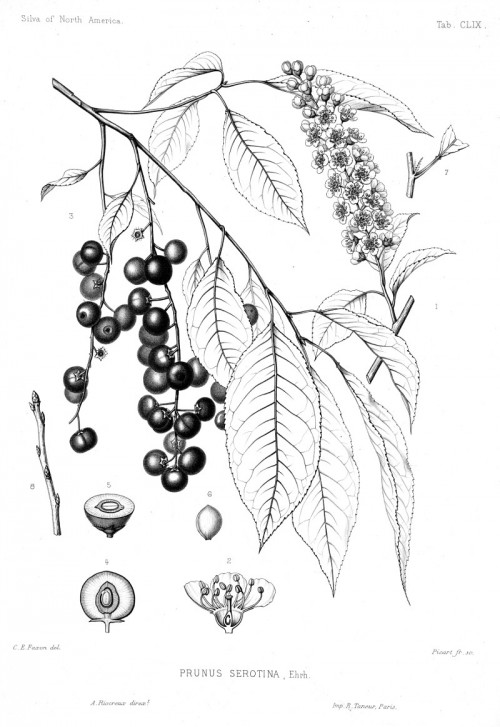Prunus serotina Ehrh. - Rosaceae - black cherry, wild Cherry, American cherry, plum cherry, rum cherry, Späte Traubenkirsche, Amerikanische Traubenkirsche
Prunus serotina var.serotina = black cherry, rum cherry (Canada, USA)
Prunus serotina var.salicifolia = Prunus capuli Cav.; Prunus salicifolia Kunth: capulín (México)
Deciduous tree, up to 15m high, native to eastern North America, cultivated as ornamental, naturalized in Europe and South America; leaves alternate, oblong-ovate, thin, toothed; inflorescence a raceme; flowers white, about 1cm across, calyx smooth within; fruit black-purple, up to 1.5cm, resembling a cherry; seed surface smooth. Seeds and leaves contain cyanogenic glycosides.
Upon hydrolization, leaves yielded 0.008% HCN.
[XCI. The constituents of the leaves of Prunus serotina., BeldingáPower, F., WatsonáMoore, C., Journal of the Chemical Society, Transactions, Vol.97, 1910, 1099-1112]
„P.serotina was widely introduced into Western and Central Europe as an ornamental tree in the mid 20th century, where it has become locally naturalized. It has acted as an invasive species there, negatively affecting forest community biodiversity and regeneration… The fruit of Prunus serotina is suitable for making jam and cherry pies, and has some use in flavoring liqueurs; they are also a popular flavoring for sodas and ice creams. The black cherry is commonly used instead of sweet cherries (Prunus avium) to achieve a sharper taste.“
http://en.wikipedia.org/wiki/Prunus_serotina
„Biochemical changes related to cyanogenesis (hydrogen cyanide production) were monitored during maturation of black cherry (Prunus serotina Ehrh.) fruits. At weekly intervals from flowering until maturity, fruits (or selected parts thereof) were analyzed for a) fresh and dry weights, b) prunasin and amygdalin levels, and c) levels of the catabolic enzymes amygdalin hydrolase, prunasin hydrolase, and mandelonitrile lyase. During phase I (0-28 days after flowering [DAF]), immature fruits accumulated prunasin (mean: 3 micromoles/fruit) but were acyanogenic because they lacked the above enzymes. Concomitant with cotyledon development during mid-phase II, the seeds began accumulating both amygdalin (mean: 3 micromoles/seed) and the catabolic enzymes and were highly cyanogenic upon tissue disruption. Meanwhile, prunasin levels rapidly declined and were negligible by maturity. During phases II (29-65 DAF) and III (66-81 DAF), the pericarp also accumulated amygdalin, whereas its prunasin content declined toward maturity. Lacking the catabolic enzymes, the pericarp remained acyanogenic throughout all developmental stages.“
[Development of the potential for cyanogenesis in maturing black cherry (Prunus serotina Ehrh.) fruits., Swain, E., Li, C.P., Poulton, J.E., Plant physiology, Vol.98(4), 1992, 1423-1428]
Main constituent of the dried stem bark („Wild cherry bark“) is prunasin, other constituents are benzoic acid, trimethyl gallic acid, p-coumairc adic and tannin. Pulverized bark is treated with warm water (55°C) so enzymes hydrolyze prunasin to benzaldehyde, glucose and hydrocyanic acid. „Distillation yields a flavour similar to Kirschwasser…“
[Reineccius, G., and H. B. Heath. „Source book of flavors.“ (1994), 216]
„…the essential oil obtained from the leaves of P.serotina promoted vascular smooth muscle relaxation. The
oil was analyzed by gas chromatography coupled to mass spectrometry and fifty seven compounds were detected. Four of the major constituents, benzyl alcohol (4) (20.3%), benzaldehyde (5) (12.1%), cinnamyl alcohol (6) (4.7%), and cinnamaldehyde (7) (1.1%) also induced a concentration-dependent relaxation of rat aorta. The greatest vasorelaxant effect was observed for compound 6 (EC50=42.2±5.7μg/ml). The results derived from this study provide a scientific basis for the traditional use of the leaves of this plant for the treatment of hypertension.“
[Vasorelaxant constituents of the leaves of Prunus serotina “capulín”., Ibarra-Alvarado, C., Rojas, A., Luna, F., Rojas, J., Rivero-Cruz, B., Rivero-Cruz, J.F., Revista Latinoamericana de Química, Vol.37(2), 2009, 164-173]
http://www.relaquim.com/archive/2009/p2009372-164.pdf
„In Mexico, P. serotina has been used since colonial times for nourishment and medicinal purposes. The fruit is commonly consumed fresh, as jam, liquors or syrups, and the seeds are consumed roasted and salted as snacks. In Mexican traditional medicine, teas and syrups prepared from the leaves and fruits are highly appreciated for treating hypertension, stomach upsets, mouth infections, diarrhea, malaria, bronchitis, and cough, and the seeds are used in decoction for the treatment of cough…
The predominant aldehyde identified in raw and toasted seeds was benzaldehyde. This compound has a characteristic pleasant almond-taste and aroma… Benzaldehyde is produced by enzymatic degradation of the cyanogenic glycosides amygdalin and prunasin. Considering on one hand that benzaldehyde content in toasted seeds was higher than that in raw seeds, and on the other, that bitterness attributed to the presence of amygdalin diminished in toasted seeds, it is very likely that the toasting process may induce benzaldehyde formation from cyanogenic glycosides…The most abundant alcohol identified in P. serotina seeds was 2,3-butanediol, which was also the major volatile compound in raw (17.03 ppm) and toasted seeds (17.44 ppm)… Pyrazines and pyrroles were other major volatiles identified exclusively in toasted black cherry seeds. These compounds are produced during the toasting process from free amino acids and monosaccharides by the Maillard reaction through Strecker degradation, particularly, ethyl-methyl‑, ethyldimethyl-, and diethylmethyl- pyrazines, are formed in the reaction of glucose and fructose with alanine and glycine. The most abundant pyrazine in black cherry toasted seeds was 2,5-dimethylpyrazine, followed by methylpyrazine, 3-ethyl-2,5-dimethylpyrazine and trimethylpyrazine.“
[Nutritional Value and Volatile Compounds of Black Cherry (Prunus serotina) Seeds., García-Aguilar, L., Rojas-Molina, A., Ibarra-Alvarado, C., Rojas-Molina, J.I., Vázquez-Landaverde, P.A., Luna-Vázquez, F.J., Zavala-Sánchez, M.A., Molecules, Vol.20(2), 2015, 3479-3495]
http://www.mdpi.com/1420-3049/20/2/3479/htm#B8-molecules-20-03479

Sargent, C.S., The Silva of North America, vol.4, t.159 (1892) [C.E.Faxon]
http://plantgenera.org/species.php?id_species=1266431
Prunus serotina
© Rolf Marschner (2006),
www.botanische-spaziergaenge.at
